Iran vs. the US, rapprochement or confrontation
I have examined Iran from another point of view on January 21, 2025 Russia – Iran relations.
International relations, particularly those of great powers, are full of various deals, treaties and other agreements. The relations between China and Russia are based dozens of treaties, which have been analyzed in details on my website, different dimensions of China – Russia cooperation: Alliances / present alliance.
Russia has recently entered in cooperative agreements with North Korea and Belarus; China has made tens of cooperative agreements with numerous prominent countries like Iran, India and Pakistan.
The Comprehensive Strategic Partnership Treaty between Moscow and Tehran is different from Russia’s treaties with the Democratic People’s Republic of Korea (DPRK) and Belarus, which include provisions on collective defense. According to Kazem Jalali, Iranian Ambassador to Moscow, the Russian-Iranian agreement includes a provision on mutual respect for the territorial integrity of the two countries.
Chinese Foreign Ministry announced that at the invitation of Iran’s First Vice-President Mohammad Reza Aref, Member of the Political Bureau of the CPC Central Committee and Vice Premier of the State Council Zhang Guoqing will visit Iran from December 3 to 4. More info of those arrangements can be found in the article “Great Powers and Hot Spots” of September 2024.
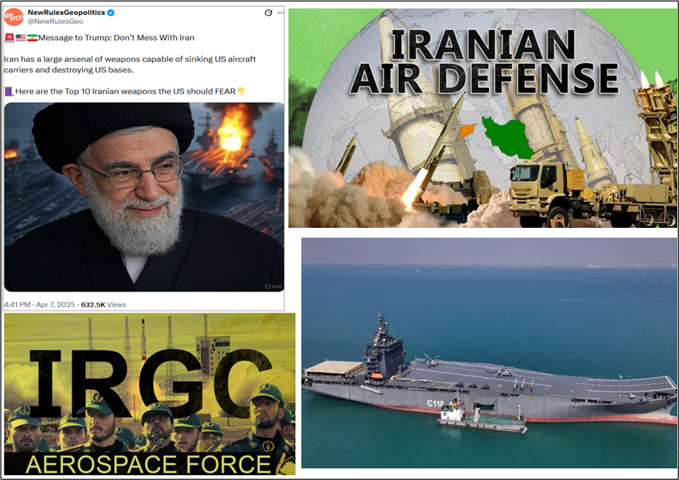
US – Iran relations, in the beginning of Trump’s presidency
Iran’s recent nuclear advances give Presiden Trump a crucial decision to make in his first months in office: to neutralize the Iranian nuclear threat through negotiations and escalating pressures; or order a military strike. Several Trump advisers privately concede Iran’s program is now so far along that this early strategy might no longer be effective. That makes a military option a real possibility.
Essentially, Iran has now two options: Firstly, to signal to the US its readiness to enter into some sort of a new nuclear deal with the Trump team and then to wait on a subsequent successful Trump–Putin meeting to re-set the global post-war security architecture. Based on that global deal, Tehran might hope to negotiate its own separate accord with the US.
The alternative option for Iran is containing higher risk. Iran has the option through exposing the improbability of victory (of Israeli strikes) and demonstrating the unacceptable cost of such conflict, to dismantle Israel’s illusory narrative of perpetual victory. The just-inked treaty of Russia-Iran may expose some new features in this respect as the data and info regarding the massive military material Iran has and is producing.
The world must return to a policy of “maximum pressure” against Iran to turn it into a more democratic country, Donald Trump’s incoming Ukraine envoy Keith Kellogg told an Iranian opposition event in Paris on January 11. Trump has vowed to return to the policy he pursued in his previous term that sought to wreck Iran’s economy to force the country to negotiate a deal on its nuclear program, ballistic missile program and regional activities. He said there was an opportunity “to change Iran for the better” but that this opportunity would not last forever. Kellogg, like many other American politicians, seems to underestimate what Iran can do.
Iran is a part of BRICS and has well developed economic relations with China and Russia. Iran’s President Masoud Pezeshkian signed a new comprehensive partnership pact with Russia, which is covering military aspects of the relation. It will help Iran to become even more sanctions proofed.
Iran’s military might
The Iranian Armed Forces, officially the Islamic Republic of Iran Armed Forces, are the combined military forces of Iran, comprising the Islamic Republic of Iran Army, the Islamic Revolutionary Guard Corps and the Law Enforcement Command.
Iranian Armed Forces are the largest in the Middle East in terms of active troops. Iran’s military forces are made up of approximately 610,000 active-duty personnel plus 350,000 reserve and trained personnel that can be mobilized when needed, bringing the country’s military manpower to about 960,000 total personnel.
The IRGC had approximately 125,000 total personnel. The IRGC Navy is now Iran’s primary force exercising operational control over the Persian Gulf, serving as a de facto coast guard. The IRGC’s Basij, a paramilitary volunteer militia, has about 90,000 active personnel.
On April 6, Iran’s Supreme Leader puts army on high alert. Iran rejected direct negotiations with the US on a nuclear deal but wants to continue indirect negotiations through Oman, a longtime channel for messages between the rival states. “Indirect talks offer a chance to evaluate Washington’s seriousness about a political solution with Iran,” said the official.
Iran’s armed forces have been placed on high alert by order of the country’s supreme leader, Ayatollah Ali Khamenei in light of President Donald Trump’s threats against Tehran.
Iran has issued notices to Iraq, Kuwait, the United Arab Emirates, Qatar, Turkey and Bahrain that any support for a US attack on Iran, including the use of their air space or territory by US military during an attack, would be considered an act of hostility, the official, who spoke on condition of anonymity, said. Such an act “will have severe consequences for them”, the official said.
Last October 2024, Israel carried out a series of strikes against Iran, almost four weeks after the Islamic Republic’s massive ballistic missile barrage on the country, which was the second missile attack on Israel since the outbreak of the war in the Gaza Strip. According to the Israeli military the October strikes targeted strategic military sites in Iran, specifically air defense systems. Then-defense minister Yoav Gallant said the Israeli strikes had weakened Iran’s offensive and defensive capabilities, leaving it at a huge disadvantage in the event of future action.
Since then, Iran has been working nonstop to reinforce its vast air defense network, relying mainly on locally-made systems.
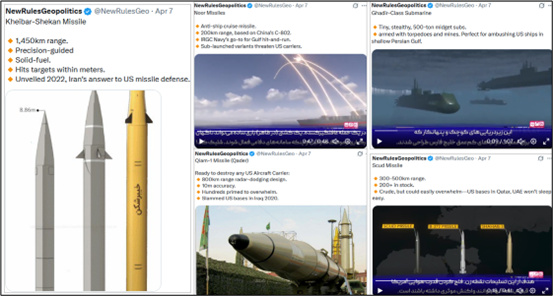
The Iranian military has begun operating another locally-made Meraj-4 S-band long-range early warning 3D electronically scanned array (AESA) radar. Satellite images posted to social networks on April 9 showed the advanced radar at a military base in the southeastern province of Khuzestan. This was reportedly the second system of this type to go operational in the Islamic Republic. The first is deployed in the southern province of Bushehr. Meraj-4 was developed by Iran Electronics Industries. The company claims that the radar has a detection range from 400 to 500 kilometers, a maximum tracking range of 200 kilometers, and a 360-degree azimuth. The radar is also said to be able to track 200 targets moving at speeds up to Mach 3 simultaneously.
In addition, the Meraj-4 is reportedly compatible with Iran’s locally-made Bavar-373 long-range air defense system, which can allegedly engage aerial targets at ranges of up to 300 kilometers. The deployment of the additional Meraj-4 radar came amid rising tensions with the US, which recently bolstered its forces across the Middle East and made direct threats to Iran over its nuclear program.
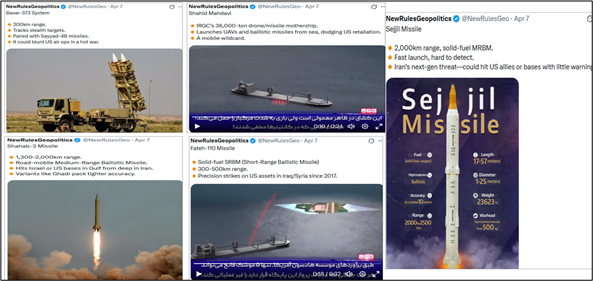
On February 6, Shahid Bagheri (C110-4) Drone Carrier was officially commissioned as a significant addition to the Islamic Revolutionary Guard Corps (IRGC) Navy. This vessel is the first of its kind in Iran and marks a significant milestone in Iran’s maritime modernization efforts. The drone carrier is expected to enhance Iran’s naval combat and intelligence capabilities, both within the Persian Gulf and beyond.
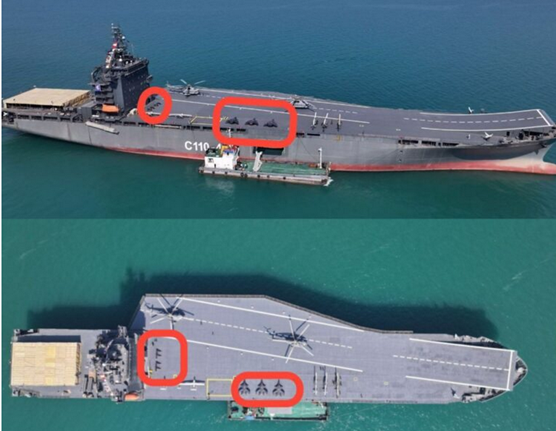
The drone carrier was constructed by converting a 42,000-ton container ship named Perarin. It has impressive dimensions, measuring 240 meters in length, 32 meters in width, and featuring a draft of 12 meters. Unique to this vessel is its 180-meter runway and an upwardly curved ramp, similar to those found on traditional aircraft carriers, designed to facilitate the efficient takeoff of drones.
As a multipurpose platform, the ship can carry a diverse array of drones and helicopters, with ample space on its lower levels for housing numerous drones, missile-capable speedboats, and additional operational equipment.
With a reported capacity to carry 60 drones and 30 fast missile boats, the Shahid Bagheri significantly enhances the IRGC Navy’s operational flexibility and firepower. As is standard for aircraft and drone carriers, the vessel is equipped with elevators that transport aircraft and essential supplies between the hangar and the deck.
The Aerospace Force of Iran’s Islamic Revolutionary Guard Corps (IRGC) unveiled a vast underground facility housing advanced missiles on March 25, amid tensions with the United States. Chief of Staff of the Iranian Armed Forces Major General Mohammad Hossein Bagheri and IRGC Aerospace Force Commander Amir Ali Hajizadeh appeared in official video footage of the unveiling.
Iranian state media said that the facility was only one of hundreds of “missile cities” that the IRGC Aerospace Force built across the country to store precision-guided ballistic missiles with a range covering most of the Middle East, such as Emad, Sejil, Qadr H, Kheibar Shekan, and Haj Qassem.
The IRGC unveiled several “missile cities” over the last few months. However, this newest one appeared to feature a basic design with less security features. For example, the facility had no blast doors separating its different sections, which could endanger all missiles stored there in case of a fire or a strike.
Iran likely unveiled the facility to send a message of strength to the US, who has been increasing its pressure and bolstering its military presence in the Middle East.

Iran Unveils Massive ‘Missile City’ Amid Tensions With U.S. (Video)
South Front, March 26, 2025
Iran – Middle East
Iran – Syria
Iran continues to send mixed signals to the Islamist-led interim government that assumed power in Syria after the fall of the regime of president Bashar al-Assad, which was allied to Tehran.
Iranian Deputy Foreign Minister, Saeed Khatibzadeh, said on April 18 that the Islamic Republic was “ready to provide support and assistance to the new Syrian government.” In addition, he emphasized that Iran is ready to offer all forms of support and assistance to the government in Damascus, so that it may attain a comprehensive role and be in a stronger and more stable position. However, Iranian Foreign Minister Abbas Araghchi said on April 19 that the Islamic Republic does not intend to establish contacts with Syria’s transitional government until it ensures security in the country.
According to the top Iranian diplomat, the Syrian issue was raised during his meeting with his Russian counterpart Sergey Lavrov. Both Iran and Russia are extremely concerned about the situation in Syria, and both sides are interested in ensuring stability and security in the region, Araghchi added.
The fall of the Assad regime was a blow to Iran. The Islamic Revolutionary Guard Corps and its affiliates were forced to withdraw from Syria, and all key supply routes to Hezbollah in neighboring Lebanon, Tehran’s closest ally, were severed by the new government.
So far, the Syrian government has shown no interest in rebuilding relations with Iran. Still, an Iranian-Syrian rapprochement can’t be completely ruled out.
On the other side, the Syrian government’s efforts to build an alliance with the West is yet to yield any results. Meanwhile, Damascus continues to face economic difficulties and the threat posed by Israel is still growing. Rebuilding relations with Tehran could help address some of these issues.
Such a move would however cause more Western pressure on Damascus. Thus, any move in Iran’s direction will likely come only after Tehran make some progress in the ongoing nuclear talks with the United States.
Iran – Saudi Arabia
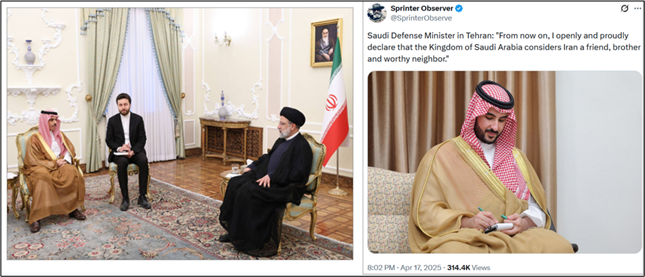
Saudi and Iranian ties strengthen on the eve of the next round of talks between Washington and Tehran. The Saudi delegation’s surprising readout from the meeting in Tehran:
Engagement and cooperation with the Islamic Republic of Iran is the cornerstone of regional security, which will lead to greater prosperity for the countries in our region. The Islamic world must act in a coordinated and unified manner against the occupation and expansionism practiced by the leaders of the Zionist entity. I came to Tehran today to present his excellency, the great Supreme Leader, with our intentions to strengthen Iran-Saudi ties at all levels, and to form a partnership deeper and stronger than ever before.
The Supreme Leader of Iran, Ayatollah Khamenei: “We are ready to help the Kingdom of Saudi Arabia in all necessary fields, and if it requests our assistance, we will oblige — as Islamic brothers”
Saudi Minister of Defense: “From now on I say openly and with pride – the Kingdom of Saudi Arabia considers Iran a friend, brother, and honorable neighbor”
This is a remarkable turnaround compared to 2015. When the Joint Comprehensive Plan of Action (JCPOA), commonly known as the Iran nuclear deal, was signed on July 14, 2015, in Vienna, Austria, between Iran and the P5+1 countries (China, France, Germany, Russia, the United Kingdom, and the United States), along with the European Union, Iran was diplomatically isolated. Even the Chinese and Russians were cooperating with the West in imposing sanctions on Iran. ISIS was stirring up a storm in Syria and fighting with IRGC forces keen on saving Assad. The Saudis were at war with the Houthis, an Iranian ally, and tensions between Riyadh and Tehran were quite high.
Houthis in Yemen
The United States military launched numerous waves of strikes against areas controlled by the Houthis (Ansar Allah) in Yemen over in March and April causing casualties and damage. At least 13 strikes have hit the port and airport in the western province of al-Hodeidah, other strikes in the capital Sanaa area and three additional strikes hit the island of Kamaran which is located in the Red Sea, off the coast of the province.
The US Central Command (CENTCOM), which oversees American military operations in the Middle East, said that it continues to conduct strikes against the Houthis in Yemen.
The strikes came after the Houthis shot down two US MQ-9 Reaper combat drones over Sanaa, April 18 and 19. The US has reportedly spent over $1 billion on its operation against the Houthis so far but still, the operation is yet to yield any concrete results. The Houthis continue to launch attacks in support of the Gaza Strip on a near-daily basis, demonstrating that their military capabilities are still intact.
Yemen’s Houthi rebel movement Ansar Allah has attacked the US aircraft carriers Harry Truman and Carl Vinson and their escort warships, the group’s spokesman Yahya Saria said. “Missile forces, drone forces and naval forces carried out a double operation and attacked the US aircraft carriers Harry Truman and Carl Vinson and their escort warships in the Red Sea and Arabian Sea using cruise missiles and drones,” the spokesman told.
With the conflict in the Gaza Strip escalating, the Ansar Allah (Houthi) movement announced that it would carry out attacks on Israeli territory and block pro-Israeli ships from passing through the waters of the Red Sea and the Bab el-Mandeb Strait until Tel Aviv halted its military operation in the Palestinian enclave. The Houthi attacks stopped after the Gaza ceasefire was imposed in mid-January 2025, but after the ceasefire collapsed in early March, the rebels first announced a resumption of attacks on Israeli ships in the Red Sea and then resumed attempts to attack targets inside Israel with missiles.
Iran has reportedly ordered its military personnel to leave areas controlled by the Houthis (Ansar Allah) in Yemen. The unnamed official told the British newspaper that Tehran was scaling back its support of its regional allies to focus on the direct threats emanating from the United States. According to the official, Iran’s pullback from Yemen was designed to avoid the possibility of escalation if an Iranian soldier is killed in US airstrikes there. Iran is the main backer of the Houthis.
Trump threatened Iran amid the operation, warning it of military consequences if it did not halt support of the Houthis. The US President later made even more serious threats to Tehran over its nuclear program.

South Front April 17, 2025
The Houthis (Ansar Allah) continue to launch attacks in support of the Gaza Strip, despite an uptake in United States strikes on Yemen. Despite the high costs and lack of results, the Trump administration appears to be determined to go on with its operation against the Houthis. In fact, recent Arab and US media reports revealed that Washington could indirectly back a ground offensive by allied Yemeni government armed factions against the group along the country’s Red Sea coast.
On April 28, the Houthis confirmed to have come close to striking an American supercarrier, the USS Harry Truman, which was forced to turn hard to evade fire. An F-18E/F Super Hornet fighter aircraft, parked on the deck, fell overboard and was lost at sea during the turn. The Yemeni anti-ship ballistic missile reportedly used a very shallow trajectory, providing minimal warning time and thus preventing escorting US Navy destroyers from intercepting it.
This represented the second missile strike by Yemeni forces that came within very close range of an American aircraft carrier, following a prior incident reported in October 2024. The loss of an F-18 follows a prior shootdown of one of the aircraft operating from the same aircraft carrier in the theatre in December, which the Houthis Coalition claimed to have brought down. The US Navy claimed the fighter was shot down by friendly fire.
Houthis are continuing to shoot down MQ-9 Reaper drones that operate closer to their airspace. Over 20 MQ-9s have been shot down since hostilities escalated in October 2023.
Other relations in the Middle East
Iran has issued notices to Iraq, Kuwait, the United Arab Emirates, Qatar, Turkey and Bahrain that any support for an attack by the United States on its territory, including the use of their airspaces or territories by US. military, would be considered an act of hostility. Such an act “will have severe consequences for them”, the official said.
Tensions between the US and Iran have been on the rise since President Donald Trump directly threatened the Islamic Republic last month with military action if it does not engage in direct talks on its nuclear program.
Saudi Arabia, the UAE, Qatar and Kuwait have already informed the US that they will not permit their airspaces or territories to be used as a launchpad against Iran, including for refueling and rescue operations. Russia said on April 3 that US threats of military action against Iran were unacceptable and the next day called for restraint.
Iran – the United States
Preparing for a possible attack on Iran, the US reinforced its military posture in the Middle East in recent weeks with a second aircraft carrier, additional strategic stealth bombers, fighter jets, combat drones and anti-missile-capable air defense systems. Trump’s recent threats and the military buildup in the region have so far failed to convince Iran to engage in direct nuclear talks.
Open-source reports suggest that the United States recently increased its military presence at Diego Garcia Island in the Indian Ocean. Commercially available satellite imagery shows that B-2 Stealth Bombers, KC-135 refueling tankers and a C-17 cargo plane recently arrived at Diego Garcia Island. The United States has not confirmed the arrival of these aircraft at the time of this writing. The military buildup comes amid the US air campaign targeting Houthi infrastructure and leadership in Yemen.
Iranian Foreign Minister Abbas Araghchi stressed again on April 6 that his country was open only for indirect talks with the US. “We remain committed to diplomacy and are ready to try the path of indirect negotiations,” the minister said. “Iran keeps itself prepared for all possible or probable events, and just as it is serious in diplomacy and negotiations, it will also be decisive and serious in defending its national interests and sovereignty.”
Despite recent escalation by the US, an attack on Iran will not likely happen unless Israel manages to convince Trump that there is no other way to address the alleged threat posed by the Tehran nuclear program. In order to prevent such a dangerous scenario, Tehran will have to engage in some form of talks with Washington.
Rounds of Nuclear Talks
As Tehran and Washington head into a second round of indirect talks on Iran’s nuclear program, a review of their past diplomatic engagements over the issue offers a sobering reminder of why Iranian officials remain skeptical of American intentions. This distrust is not rooted in ideology or emotion but in experience. As Ayatollah Ali Khamenei recently stated Iran’s refusal to engage in direct talks with the United States stems from hard-earned lessons. The peak of that “experience” is Washington’s unilateral withdrawal from the Joint Comprehensive Plan of Action (JCPOA), commonly known as the Iran nuclear deal and its imposition of the draconian and harshest sanctions in history, despite Iran’s compliance.
Iran’s Foreign Minister was recently in Moscow, meeting with President Putin, to discuss the planned talks with the US delegation in Oman.Iran’s chief concern at this time is trying to assess whether or not Witkoff’s position, as presented last Saturday, has fundamentally shifted. Initially, Witkoff signaled that the US was willing to accept a cap on Iran’s uranium enrichment—referencing the 3.67% limit from the 2015 deal—rather than demanding the complete dismantlement of Iran’s nuclear program, a stance more in line with Israel’s demands. However, within days of returning to Washington, Witkoff publicly reversed course, stating that any final deal must require Iran to “stop and eliminate its nuclear enrichment and weaponization program.”
Iran will likely attempt to use nuclear negotiations with the United States to delay a potential strike on its nuclear facilities and the imposition of snapback sanctions. Iran may propose that Iran and the United States first negotiate an “interim deal” prior to beginning negotiations on a comprehensive nuclear agreement.
Iran and the P5+1 (the United States, the United Kingdom, China, France, Russia, and Germany) reached an interim deal in 2013 that froze elements of Iran’s nuclear program in exchange for temporary sanctions relief prior to further negotiations that led to the Joint Comprehensive Plan of Action (JCPOA) in 2015. US President Donald Trump reportedly set a 60-day deadline to reach a new nuclear agreement, which will begin on April 12. Trump previously warned on March 30 that “there will be a bombing”, if Iran does not agree to a new nuclear deal.
Senior Iranian officials persuaded Iranian Supreme Leader Ali Khamenei to approve negotiations with the United States in March 2025 to avoid being forced to fight a “two-front war” against the United States and the Iranian people. Khamenei reportedly only decided to approve negotiations after he was convinced that a failure to accept negotiations could lead to a war that, in combination with a poor economic situation, would seriously threaten the regime’s stability.The negotiations buy Khamenei more time to address regime stability, even if negotiations ultimately fail and the United States or Israel strike Iran.
It is obvious that Vladimir Putin is doing behind the scenes, most likely in concert with Xi Jinping, to help shape the deal between the US and Iran by assuring Donald Trump that Russia is fully committed to preventing Iran from building and using a nuclear weapon.
US and Iran hold “constructive” first round of nuclear talks
12 April, Iran and the UShave concluded a first round of talks in Oman over Tehran’s nuclear program – the highest-level meeting between the two nations since 2018. Both countries described the meeting as “constructive” and confirmed a second round of discussions will take place next week – with the US hailing the “direct communication” as being key to striking a possible deal. The talks are seen as an important first step in establishing whether a deal can be done.
At two-and-a-half hours, the first meeting was brief, reportedly respectful – and set the stage for a second round. That was probably as good as it could get, when Iranian and US officials sat down in Muscat, the capital of Oman – whose top diplomat mediated the primarily indirect negotiations. This meeting ran with the delegations in separate rooms, relaying messages through Oman’s foreign minister Busaidi. The heads of delegations, Araghchi and Witkoff, did speak for a few minutes in the presence of Busaidi – not the direct talks US officials said would happen but what could be a small but significant opening.
In a statement following the talks, the White House said the discussions “were very positive and constructive”, noting that Witkoff had emphasized to Iran that he had instructions to resolve the adversaries’ “differences through dialogue and diplomacy, if that is possible”. Araghchi had said ahead of the discussions that his country wanted a “fair agreement”.
The most important issue at stake is what kind of deal each side would be willing to accept. Trump sent a letter to Iran’s supreme leader saying he wanted a deal to prevent Iran from acquiring nuclear weapons and to avert possible military strikes by the US and Israel. Iran hopes for a deal to limit, but not dismantle, its nuclear programme in exchange for sanctions relief.
Progress reached during second round of Iran-US Talks
Optimism seems more palpable on the Iranian side. Foreign Minister Abbas Araghchi said the two sides had found significantly more common ground in Rome than in Muscat. His remarks suggest that momentum is building and that real progress may be on the horizon.
Negotiations on the Iran-US nuclear deal move ahead and made possible with Russia’s help. On Saturday, April 19, the second round of talks between Iran and the US was held in Rome with Oman acting as a mediator. The primary goal is to reach a comprehensive and long-term agreement, which includes:
- Iran’s complete renunciation of the development of nuclear weapons
- the lifting of all sanctions against Tehran
- the preservation of Iran’s right to a peaceful nuclear program
The negotiations between the US and Iran have gained momentum and Iran’s Foreign Minister Abbas Araghchi expressed optimism: “We have managed to reach a better mutual understanding on a number of principles and objectives, which allowed us to move to the next phase consultations,” he wrote on social media.
One of Iran’s key concerns is external guarantees in case the US breaks the agreement and reimposes sanctions, as it did in 2018. According to Araghchi, the only reliable guarantee would be a treaty ratified by the US Congress but this seems unlikely. An alternative guarantee could be a mechanism for financial compensation. A third option would be for Russia or a third party to return to Tehran its stockpile of highly enriched uranium currently held abroad.
The US’s main concern is preventing Iran from enriching uranium to weapons-grade levels and removing any existing stockpiles. Washington is reportedly ready to drop its demands for dismantling Iran’s nuclear program if the enriched uranium is transferred to Russia. Sanctions are to be lifted in exchange for Iran bringing its civilian nuclear program back under IAEA oversight.
According to a US official, neither Iran nor the US wants the UN to play a role in the new deal. This gives Russia a central position as mediator and arbiter in US-Iran relations, effectively sidelining former guarantors France and the UK.
Thus, President Putin fulfilled his promise to President Donald Trump a month ago — Iran must not be allowed to destroy Israel. This breakthrough marks what may be Trump’s first major international victory. It’s believed the details with Tehran were discussed during Araghchi’s recent visit to Moscow.
Further technical negotiations between Iran and the US are scheduled to take place next week in Geneva, followed by another high-level meeting in Oman over the weekend.
Third round of indirect talks between US – Iran concludes in Oman
According to the Omani Foreign Ministry, the talks between the US and Iran will continue next week with another high-level meeting slated for May 3
April 26, the third round of talks between Tehran and Washington on settling the crisis around Iran’s nuclear program, held in Oman on political and expert levels, has concluded. According to it, the delegations of experts from the two countries managed to single out certain details with regard to expectations and demands of the parties to the future agreement. It is noted that the current stage of dialogue has concluded because both teams have to return home to receive further instructions from their governments.
According to the Omani Foreign Ministry, the talks between the US and Iran will continue next week with another high-level meeting slated for May 3. The negotiations revealed common aspiration for reaching a mutually respectful agreement, it stressed.
Fourth round of indirect talks between US – Iran postponed
Omani Foreign Minister Al Busaidi said that the meeting was postponed for “logistic reasons”. A possible new date for the negotiations was not announced.
Iran’s position, backed by Russia and China
Iran is preparing for negotiations with the US knowing the firm back by Russia and China.
Iran was welcomed into BRICS in the summer of 2024 and followed that milestone by signing the Iranian–Russian Treaty on Comprehensive Strategic Partnership on January 17 in Moscow. Notwithstanding the fall of Bashir al-Assad in December 2024, with the West celebrating this as a major defeat for Tehran, Iran had strengthened its military capabilities, thanks in part to Russian assistance. Iran’s relationship with both Russia and China has expanded and deepened during the last three years.
Iran, China, and Russia issued a joint statement on March 14 effectively condemning the US “maximum pressure” strategy vis-a-vis Iran. The statement came from a meeting of the Iranian, Chinese, and Russian deputy foreign ministers in Beijing. The statement called on “relevant parties”—a reference to the United States—to “lift all illegal unilateral sanctions” on Iran. The statement described Iranian nuclear activities as “exclusively for peaceful purposes,” despite numerous indications that Tehran has restarted its nuclear weapons program.
While most of media and public attention in the West are fixated on Trump’s tariff attack on the global economy, the Chinese and Iranians flew to Moscow and met with senior Russian officials. The meeting is described as, “expert-level consultations on the Iranian nuclear program “. This is happening as the Russian legislative body approved the Comprehensive Strategic Partnership Treaty between the Russian Federation and the Islamic Republic of Iran, which was signed by the Russian and Iranian presidents on January 17.
According to Article 10 of the Treaty: The Contracting Parties shall closely cooperate on arms control, disarmament, non-proliferation and international security within the framework of relevant international Treaties and international organizations to which they are parties, and regularly consult on these issues.
The key phrase is “non-proliferation.” If Iran proceeds to develop an operational nuclear device, this would invalidate this agreement. The Iranians will not do that. They understand that they will have more security with Russia on their side as long as they do not proliferate, than they would if the decided to build a nuclear warhead.
Now the Chinese have joined the meeting. The Russian and Chinese experts are helping Iran define and explain its nuclear program to the United States in order to persuade Donald Trump that Iran is not pursuing a nuclear weapon.
Last week, Russia’s Foreign Ministry said that Moscow remains committed to finding solutions to Iran’s nuclear program that respect Tehran’s right to peaceful nuclear energy. “The use of military force by Iran’s opponents in the context of the settlement is illegal and unacceptable,” Maria Zakharova, spokeswoman for the ministry, told reporters. “Threats from outside to bomb Iran’s nuclear infrastructure facilities will inevitably lead to an irreversible global catastrophe. These threats are simply unacceptable.”
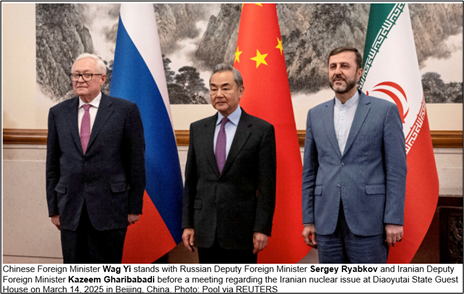
While Iran has continuously rejected direct talks with Washington, it has said it will consider indirect negotiations through Oman, a longtime channel for communication between the two adversaries. Tehran has also stated that the country’s missile program would be off limits in any such nuclear discussions.
Here is what the Russian Foreign Ministry said recently with respect to possible negotiations:
“I think Russia and China will encourage Iran to agree again, to the JCPOA limitations, with the commitment that Russia and China will, along with the United States, guarantee compliance. Iran, for its part, will insist on the lifting of economic sanctions as well as an end to US attempts to subvert the Iranian government.
The major obstacle to reaching an agreement will be the Trump administration’s demand that Iran end all support for Hamas, Hezbollah and the Houthis. This week’s meeting with the Russians and the Chinese will give Iran the confidence that it has the backing of two great powers and will hold firm in protecting its national security interests.”
Iran – Russia – China, a triangle game of multipolar axis. Comprehensive Strategic Partnership Treaties between China – Russia, Iran – Russia and Iran – China are formalizations of friendly intentions and represent an institutional consolidation of an axis that effectively forms a multipolar block resisting the decaying Western hegemony. The Moscow-Beijing-Tehran triad is no longer merely an informal arrangement – it is a political, military and economic architecture with solid foundations, common principles, and a shared strategic vision.
The emphasis on jointly developing the North-South International Transport Corridor – which connects Russia to the Persian Gulf through Iranian territory – also represents a significant blow to the logistical and commercial hegemony of the North Atlantic. This infrastructure project, combined with China’s Belt and Road Initiative, is repositioning the gravitational centers of global trade, shifting them toward the Eurasian axis.
The treaties with Iran directly echo the fundamentals of the Russia-China Comprehensive Partnership, established in recent years as a coordinated response to NATO expansion, the US military encirclement in the Indo-Pacific, and economic militarization through sanctions.
This symmetry between the agreements is not accidental. It reflects a shared strategic planning, based on strengthening multilateralism, rejecting external interference, and building a multipolar world order – where power centers are no longer concentrated in Washington, London, or Brussels. A New Order in the Making. The ratification of the treaties is a firm step toward the consolidation of a new international order.
Joint naval exercises. Starting in late 2017 or early 2018, Iran persuaded Russia and China to join in an annual naval military exercise. The first one kicked off in March 2019 and there has been one every year since then at the same time, the first week of March. The Russians, Chinese and Iranians completed a joint-military exercise in mid-March — it was their seventh consecutive annual exercise. So, the three countries have a proven history of working together collaboratively on issues of national security.
Chinese Satellite Imaging Firm Helping Houthis Target US Warships. The US State Department has issued allegations centered on Chinese firm, Chang Guang Satellite Technology, saying it is directly supporting attacks by Houthi fighters against American interests. This firm is well-known to be close to the CCP government, and is already under Western sanctions. The statement was issued in the wake of a Financial Times report which said the firm is supplying the Houthis with satellite imagery used in targeting. If it does have a role in Yemen, this will further damage already severely strained US-China relations mid the tariff war, given the Houthis have frequently directly targeted US warships, including the carrier USS Harry S. Truman with drone and missile attacks. The USS Carl Vison carrier is about to joint the Truman in patrolling regional waters, also as tensions heat up with Iran.
US war with Iran?
There are speculations about a potentially imminent US war on Iran. Some conclude that a war is more likely than not, whereas others are ambivalent but also seem to expect a kind of conflict. President Trump (or Netanyahu behind him) has made demands towards Iran that are designed to be rejected: end all nuclear programs, destroy medium range missiles which can reach Israel, stop support for all ‘resistance’ movements in the Middle East.
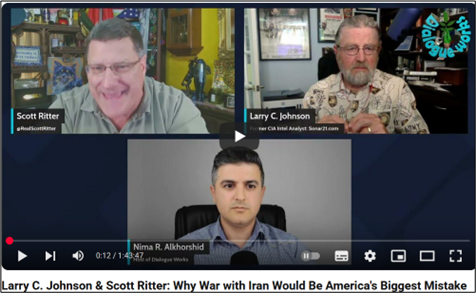
Larry C. Johnson & Scott Ritter: Why War with Iran Would Be America’s Biggest Mistake
Dialogue Works, by Nima R Alkhorshid, April 1, 2025
Iran rejects those demands and is willing to put its nuclear program back into the parameters of the JCPOA nuclear agreement, which Trump previously discarded, if sanctions against it are lifted. It is also willing to do lucrative business with the US.
The US is trying to impress Iran with recent military arrangements. However, this appears to be a mere show of force mostly for the audience in the US. It is not enough for a sufficiently strong attack that aims to defeat Iran. Iran’s abilities to retaliate require a much larger force for the opening campaign and many more forces to handle all the calamities which would inevitably follow.
Trump’s envoy Steve Witkoff was in Oman for talks with Iran’s Foreign Minister Abbas Araqchi. The first reactions are positive: “Talks were held in a constructive atmosphere, based on mutual respect,” and the delegations exchanged the views of their respective governments about “Iran’s nuclear program and sanctions relief with the mediation of Oman FM,” says the MFA statement. The talks will continue.
It is hard to assess what Trump might do next. He may be eager to score a diplomatic win. Trump may embrace JCPOA 2 as his creation and proclaim himself as the one who stopped Iran from building a nuke. Then again, as Alastair Crooke reminds us, the current volatile international situation may make random events more relevant in creating the outcome. Simple moves, from potentially many sides, (an Israeli attack on Iran?) could easily have snowball effects.
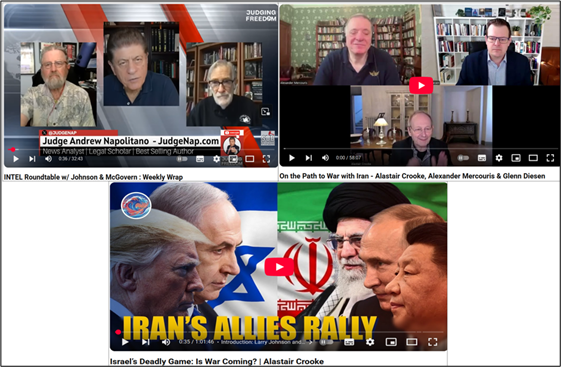
INTEL Roundtable w/ Johnson & McGovern : Weekly Wrap
Judge Napolitano – Judging Freedom, April 11, 2025
On the Path to War with Iran – Alastair Crooke, Alexander Mercouris & Glenn Diesen
The Duran, April 12, 2025
Israel’s Deadly Game: Is War Coming? | Alastair Crooke
Counter Currents, Larry Johnson and Alastair Crooke, April 19, 2025
Tensions in the Middle East are escalating, with Israel, Iran, and the U.S. at the center of a potential conflict. In this eye-opening interview with former UK diplomat Alastair Crooke, we dive deep into Israel’s internal divisions, the shifting policies of Donald Trump, and the real story behind Iran’s nuclear program. Israel’s secretive plans for an attack on Iran, coupled with U.S. involvement, could set the stage for a dangerous war.

Will Russia Defend Iran If US Attacks? | Fmr. CIA analyst Larry Johnson
Counter Currents, April 7, 2025
Former CIA analyst Larry Johnson breaks down the real reasons behind U.S.-Iran tensions, revealing how Russia might step in if war breaks out. Forget the nuclear hype—this is about trade routes, BRICS, and power plays. Russia and Iran just signed a major deal… and it could change everything.
Ex-CIA Analyst Larry Johnson on Iran and China Power Play
Natural Resource Stocks, April 16, 2025
Is Donald Trump Only Trying to Derail Negotiations with Iran?
1 May 2025 by Larry C. Johnson
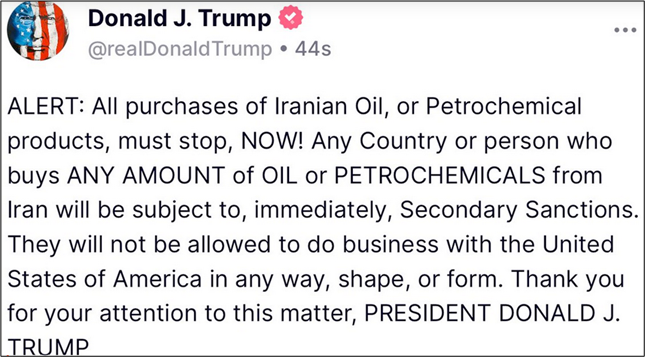
Larry Johnson is asking an interesting question in his recent article and gives an interesting answer to it:
“At first glance, Donald Trump’s recent post on Truth Social appears to be a deliberate effort to sabotage the negotiations with Iran to ensure that Tehran ends all efforts to build a nuclear weapon. And maybe that is his intent. But, when you step back and look at the countries who import Iranian oil or petrochemicals, you will realize that Trump is going after three countries… India, China and Turkey, with China as the primary target. Iran is just an excuse.”
“If Trump makes good on his threat to add sanctions to those countries that buy Iranian oil and petrochemicals, he is only going to exacerbate the already dismal relations with China. While Trump may hope that the economic pain from the US sanctions will compel Xi Jinping to alter Chinese trade policy and kow tow to Washington, his actions are viewed in China — not just by the leaders, but by the average Chinese man and woman in the street — as an act of war. Given China’s long history of being bullied and punished by Westerners, this is not going to sit well with the Chinese populace.”
The latest US sanctions, imposed some weeks ago, have managed to disrupt trade as the number of non-sanctioned tankers is steadily falling but exports from Iran to China continue at a rate similar to those of the past few months. They have not worked as expected. The new secondary sanctions are targeting Iran’s best customer – China. No doubt, despite the threat of secondary sanctions, China will continue to buy oil from Iran.


